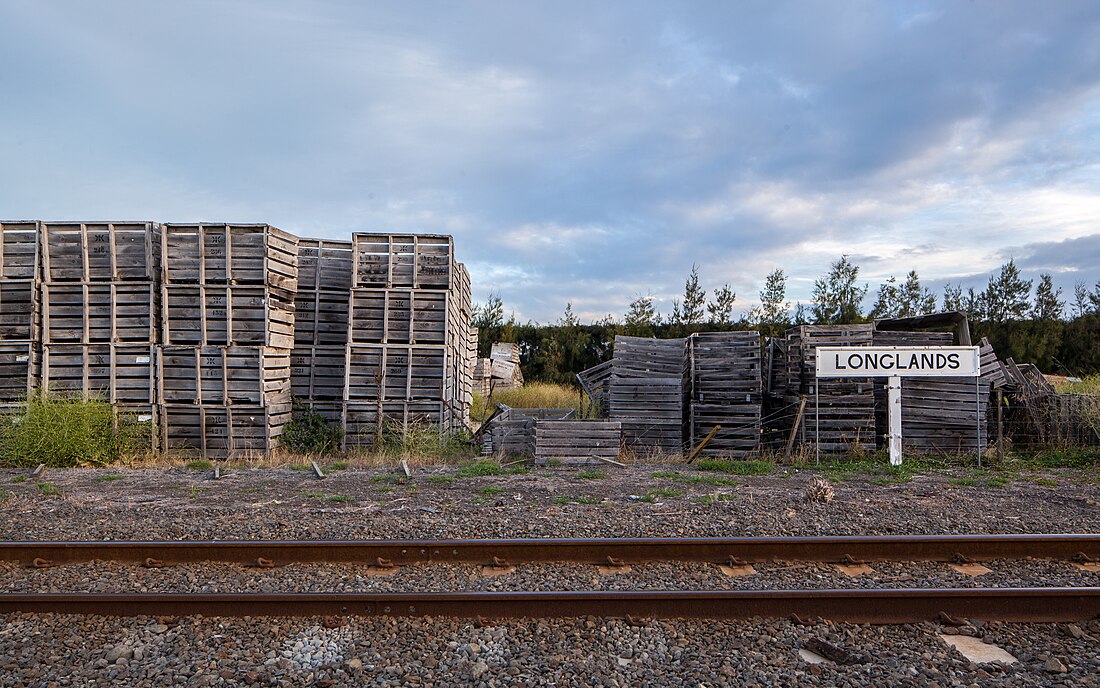Longlands, New Zealand
Rural community in Hawke's Bay Region, New Zealand From Wikipedia, the free encyclopedia
Longlands is a rural community in the Hastings District and Hawke's Bay Region of New Zealand's North Island. The area is on the southern and western outskirts of Hastings city.
Longlands | |
|---|---|
Rural community | |
 Apple boxes at Longlands | |
 | |
| Coordinates: 39.660°S 176.834°E | |
| Country | New Zealand |
| Region | Hawke's Bay Region |
| Territorial authority | Hastings District |
| Ward |
|
| Electorates | |
| Government | |
| • Territorial Authority | Hastings District Council |
| • Regional council | Hawke's Bay Regional Council |
| Area | |
• Total | 38.85 km2 (15.00 sq mi) |
| Population (June 2024)[2] | |
• Total | 2,520 |
| • Density | 65/km2 (170/sq mi) |
| Postcode(s) | 4172, 4174, 4175, 4178 |
The Longlands Estate occupied much of the land around 1880,[3] but was broken up into smaller farms and a freezing works in the early 20th century.[4][5][6]
The area is a centre for growing fruit and vegetables.[7]
Demographics
Summarize
Perspective
Longlands (including Irongate and Pakipaki), covers 38.85 km2 (15.00 sq mi)[1] and had an estimated population of 2,520 as of June 2024,[2] with a population density of 65 people per km2.
| Year | Pop. | ±% p.a. |
|---|---|---|
| 2006 | 2,091 | — |
| 2013 | 2,049 | −0.29% |
| 2018 | 2,253 | +1.92% |
| Source: [8] | ||
Before the 2023 census, Longlands had a larger boundary, covering 39.55 km2 (15.27 sq mi).[1] Using that boundary, Longlands had a population of 2,253 at the 2018 New Zealand census, an increase of 204 people (10.0%) since the 2013 census, and an increase of 162 people (7.7%) since the 2006 census. There were 762 households, comprising 1,182 males and 1,074 females, giving a sex ratio of 1.1 males per female, with 426 people (18.9%) aged under 15 years, 366 (16.2%) aged 15 to 29, 1,071 (47.5%) aged 30 to 64, and 396 (17.6%) aged 65 or older.
Ethnicities were 82.3% European/Pākehā, 20.1% Māori, 5.9% Pacific peoples, 2.9% Asian, and 2.3% other ethnicities. People may identify with more than one ethnicity.
The percentage of people born overseas was 16.6, compared with 27.1% nationally.
Although some people chose not to answer the census's question about religious affiliation, 46.5% had no religion, 43.8% were Christian, 1.6% had Māori religious beliefs, 0.3% were Hindu, 0.1% were Muslim, 0.3% were Buddhist and 1.7% had other religions.
Of those at least 15 years old, 345 (18.9%) people had a bachelor's or higher degree, and 309 (16.9%) people had no formal qualifications. 348 people (19.0%) earned over $70,000 compared to 17.2% nationally. The employment status of those at least 15 was that 1,008 (55.2%) people were employed full-time, 318 (17.4%) were part-time, and 39 (2.1%) were unemployed.[8]
Railway station
Longlands flag station on the Palmerston North–Gisborne Line opened in 1912, after a deputation met the Minister of Railways,[11] following the opening of a sheep and cattle yard in 1911.[12][13] The line through Longlands, from Hastings to Paki Paki, had opened on 1 January 1875,[14] the last works being to complete the bridge over the nearby Irongate Stream, formerly the Ngaruroro River.[15][16] The piles of that bridge sank soon after construction.[17] A shelter shed was built at Longlands in 1905,[13] to the south of Longlands Road.[18] In 1936 Longlands was a main centre for railing cattle.[19] In 1947 frame levers at Longlands tablet locked siding were fitted with chains, staples, and a points lock.[13] The station closed to all traffic on 18 May 1980, but a service siding was retained for about a decade.[14]
References
Wikiwand - on
Seamless Wikipedia browsing. On steroids.
